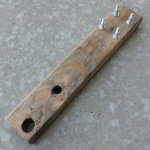havoc_squad
Senior Chief Petty Officer
- Joined
- Mar 5, 2011
- Messages
- 702
I am on the last part of the electrical/ignition teardown of the powerhead of 1990 V4 90 HP crossflow outboard, which is trying to get the rectifier/regulator freed of the gasket on the powerhead.
Everything else has been removed involving the flywheel, charge coil, timer base, power pack, etc.
1. Is there any tips on getting this thing off without buying an adjustable spanner wrench, like what is used for the lower unit driveshaft seal cover?
2. How do you nudge the flywheel key out of the crankshaft when it is wedged in? Trying to avoid destroying the tip of a screwdriver and prevent defacing the flywheel section of the crankshaft.
I "read" that the rectifier/regulator is one of those parts you don't want to be going and prying where the gasket is, but use other methods to get it off.
I Cautiously gave some lumps to nudge it around in key spots with dead blow polymer hammer and a metal punch with leather on the tip to prevent deforming the housing, but couldn't get anything to budge.
If adjustable spanner is the only effective option, where to get it and what size/model is best to get? I seriously doubt iBoats carries that specific of a tool.
I measured something around 3 inches possible working, unless you needed to span it long-ways, which would require a 4 inch span.
Everything else has been removed involving the flywheel, charge coil, timer base, power pack, etc.
1. Is there any tips on getting this thing off without buying an adjustable spanner wrench, like what is used for the lower unit driveshaft seal cover?
2. How do you nudge the flywheel key out of the crankshaft when it is wedged in? Trying to avoid destroying the tip of a screwdriver and prevent defacing the flywheel section of the crankshaft.
I "read" that the rectifier/regulator is one of those parts you don't want to be going and prying where the gasket is, but use other methods to get it off.
I Cautiously gave some lumps to nudge it around in key spots with dead blow polymer hammer and a metal punch with leather on the tip to prevent deforming the housing, but couldn't get anything to budge.
If adjustable spanner is the only effective option, where to get it and what size/model is best to get? I seriously doubt iBoats carries that specific of a tool.
I measured something around 3 inches possible working, unless you needed to span it long-ways, which would require a 4 inch span.






















